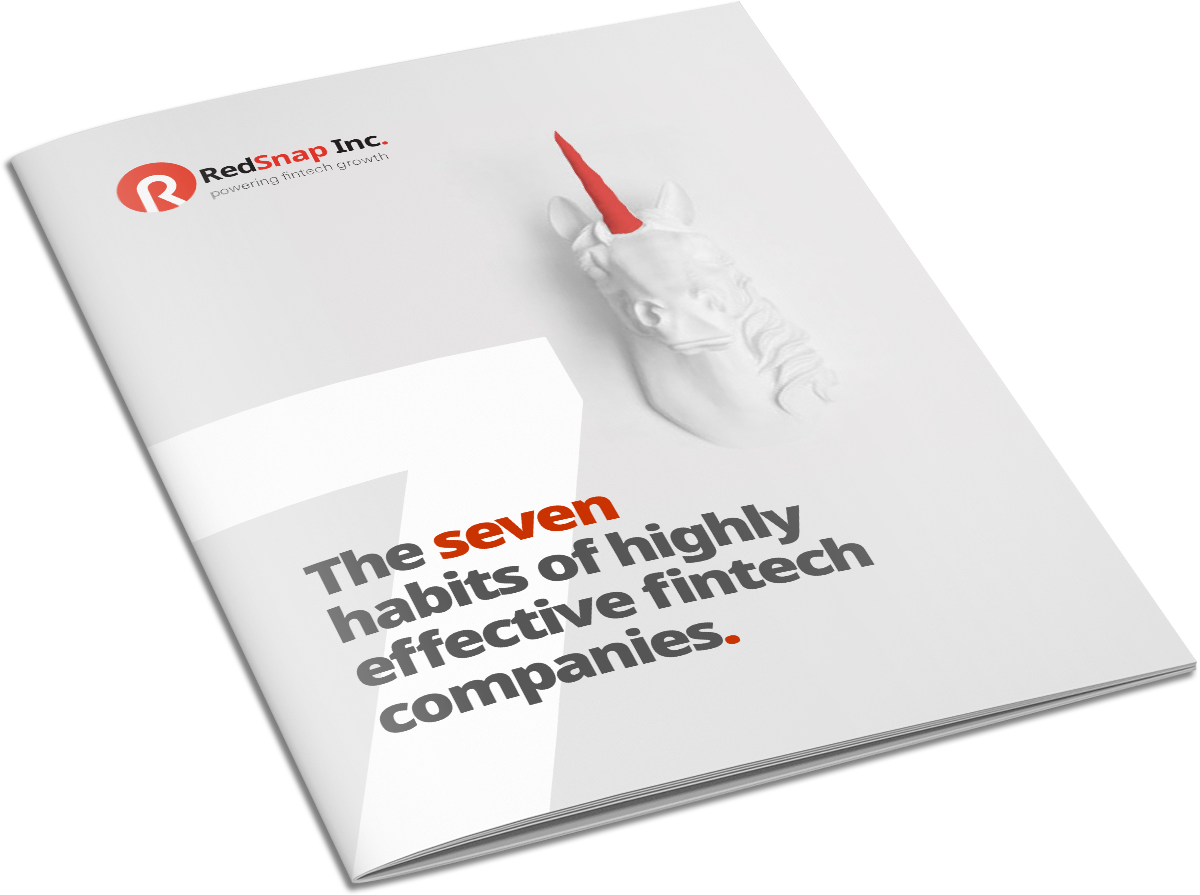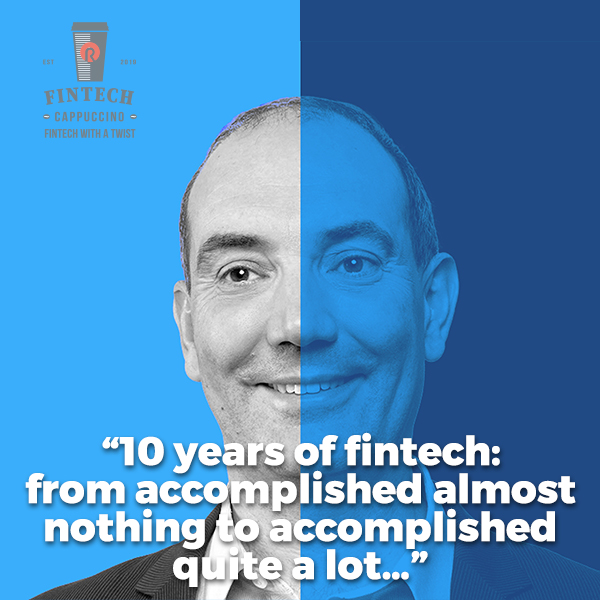The foundation of any successful go to market strategy ...
Marketing
Sales
Automation
For business leaders
For sales leaders
For marketing leaders
RedSnap Inc.
RedSnap Inc. is an agency for fintech branding, marketing & sales. We power fintech growth by aligning your marketing & sales. We develop appealing brands, impactful marketing campaigns and successful sales strategies that truly drive growth. Let’s simply say: we make sure your (potential) clients see you, like you and buy you.
For fintechs
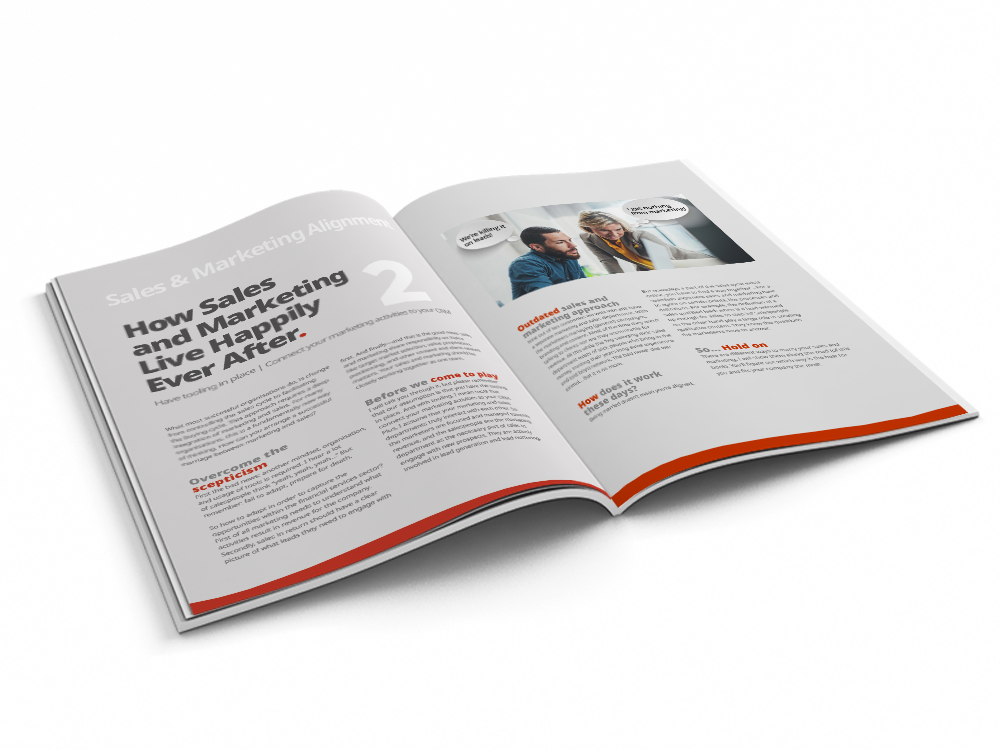
Download here.
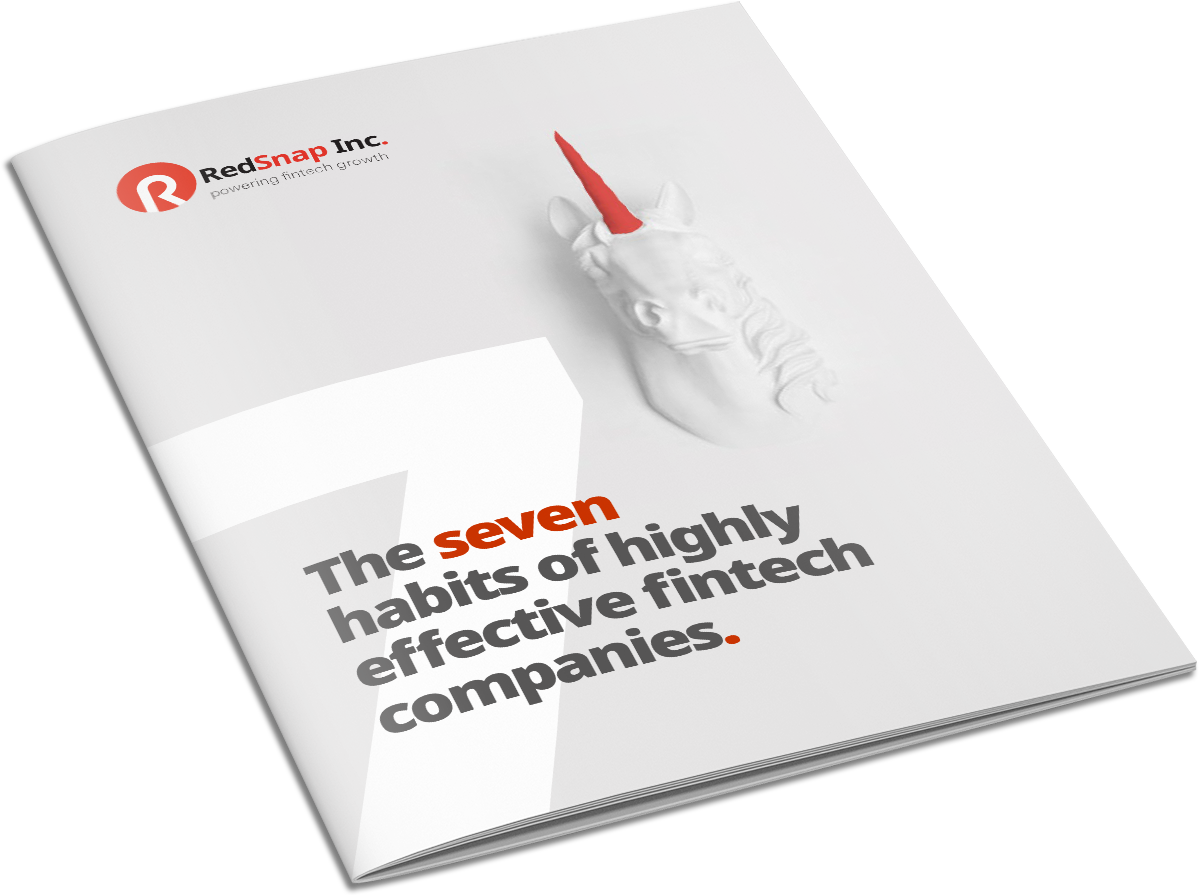
eBook 7 habits of highly effective fintech companies
Fintech
Mind the Gap!
Spending money is easy, sounds fun, and gives people a bit of a rush. So why aren't your potential customers in the financial services industry throwing their money at you? They should be because your product is solving a major problem for them.
But before banks buy your product (or service), you first need to convince the buying committee. The people on this committee make sure that the banks money is well spent. Here is how you deal with them in order to close a deal.
So what and whom are we talking about?
Before we get lost in marketing and sales lingo, let's define what's what:
- Buyer persona: a semi-fictional representation of your ideal buyer based on data, interviews, and some educated guesses.
- Buying committee: the group of buyer personas that are involved in the decision to buy something.
- DMU: the decision-making unit. This is a combination of the buying committee and the buyer personas.
In general, marketers use buyer personas, and sales use DMU, but it comes down to the same in the end. As long as you understand that sales and marketing must work together to convince the buying committee to pick their product. That means that everybody on the committee needs to be at least neutral, or better: give a thumbs up.
Hello gorgeous, who are you?
We first need to get to know the buying committee. Think of your individual buyer personas as if you want to date them: you want to know every (cute) little detail about them. In business, this means that you need to know their interests, responsibilities, KPI's, what they read, what their educational level is, some personality traits, etcetera.
This way, you define how to get their attention by offering them great content or support to do their job.
To get a head start, you can first define the type of buyer. Within the financial services industry, you can define four types:
- The power sponsor
The power sponsor ultimately decides if the bank will spend money (please be aware that doing nothing is also a popular decision). The power sponsor is the budget holder or grants the budgets. Most of the time a power sponsor will only grant a budget if the majority of the buying committee is positive about the project. Please be aware that technology is often only part of the puzzle the banker has to solve. The more complex your product or service, the more senior or higher up the ranks the power sponsor is within the bank.
A forthcoming mistake for scale-ups is that they don't check the buying process (and thus budget consequences) with the power sponsor. They start lengthy and costly sales cycles within a bank without checking if the person who needs to pay for this is OK with the process and actually has the money. - The sponsor
The sponsor has a personal or business interest when the bank buys (or not buys) your product or service. First, you need to categorise the sponsor, aka influencer, as a positive or negative sponsor. You need at least one positive sponsor to navigate you through the organisation. Without a positive sponsor, you need to walk away from the case. Banks have complex (formal and informal) organisations, so you need a friend to help you. - The user
If the bank buys something, things will change. Most likely, people will have to change their way of working or at least get a different user interface. Change is hard on people; humans are not wired for change. Remember that and take them by the hand. If you find they have (too much) adversity to change, most likely they will not buy your product or service. - The (Technical) gatekeepers
These are the people who can't say 'yes, we do it', but can (and will often) say 'no'. Most banks have lots and lots of gatekeepers that you have to convince. So be sure to have an answer ready for all the gatekeepers in Purchasing, Risk, Compliance, IT, Security, vendor management, middle management and the likes.
You can't shoot them all, so you have to work with the gatekeepers. Understand what is essential for them and help them get it. The gatekeepers are just doing their job, and from a highly regulated and complex banks perspective, they need these people to do their job well.
And for those who think salespeople are lazy, the bummer comes now....
All people on the buying committee have their own reasons and views on whether they want to buy your product or service or not. These reasons are often even very personal. Because the people in the buying committee are from different disciplines within the bank, they can have wildly different motives and expert views on the decision.
Your sales team will have to make many different value propositions to these different people within the bank. Four (4) propositions are the minimum: one for the power sponsor, one for the sponsors, one for the users and at least one for all the NO-sayers.
So everybody who says that sales is a walk in the park should realise that it is Champions League level sales if you sell into a bank. It takes hard work and interaction with lots of different people. But oh, the reward of the sale can be so sweet.
In our next blog we will talk about the competition analysis and why you should never underestimate your competition.
The Series
Mind the Gap.
-
From lead to deal1: The sales game has changedFacilitate the buyer's journey, change your mindset
Lack of structure and a lot of creativity. Are these the characteristics that come to mind when asked to describe a great salesperson? Not really right? Yet, the best sales people I know in the industry are not very structured, not very organised nor disciplined.
-
Sales & Marketing alignment2: How Sales and Marketing live happily ever afterHave tooling in place | Connect your marketing activities to your CRM.
In our article 'From lead to deal: The sales game has changed' we observed that successful organizations changed from controlling the sales cycle to facilitating the buying cycle. This approach requires a deep integration of marketing and sales. For many organizations this is a fundamentally new way of thinking. How can you arrange a successful marriage between marketing and sales?
-
Branding & identity3: Who do you think you are?How to get your branding in place.
Welcome to our ‘mind the gap’ article about brand & identity. Let’s first make sure we are all on the same page about the terminology because the language used is often misunderstood. Brand: Your brand is a combination of a visual identity, tone of voice and behaviour - most visibly expressed through your logo, taglines and images used in communication campaigns.
-
Positioning4: Finding the right positionPositioning is all about differentiation.
Welcome to our ‘mind the gap’ article about positioning. Here we will discuss the importance of positioning and how it can help you stand out from your competitors. How many times have you walked into a bank to pitch for a piece of business only to be told ‘we already have the functionality you offer’ or ‘we solved that problem a long time ago’.
-
Value proposition5: Value proposition: the extra mileWhat problem do we solve and for whom?
In this ‘mind the gap’ article we will discuss the value proposition and how it will help your fintech sales efforts in the financial services sector. That is, if applied correctly... Going the extra mile...
-
Target markets6: Finding your target audienceHow do you enter the considerable and risk-averse market of banks?
Most Fintechs face the same challenges in finding their target audience. They have a fantastic product which solves a problem for a bank. But how do they enter the considerable and risk-averse market of banks? A challenge like this isn’t a day at the beach, or is it?
-
Competition analysis8: The illusion of the special snowflakeNever underestimate your competition
A lot of fintechs might feel the urge to skip the competition analysis. Simply because they feel they don’t have any competitors. Their product is a unique solution, so why bother with looking at what others do? Well, fintechs should worry because there is always some competition; ‘special snowflake-ness’ is an illusion.
-
Sales & Engagement approach9: Stop selling. Start giving!Just selling for the sake of it has and will never work.
It might come as a surprise to you, but focusing on selling is sometimes the worst thing a sales organisation can do. A much better approach is to focus on the problem you solve for your customers and how can you help them navigate the deal through their own organisation.
-
Pipeline Optimization10: Hot or not?Optimize your sales pipeline and find the most effective way from lead to deal.
Phrases like 'pipeline optimization' that we use in our Sales & Marketing businesses do not always sound exciting. Nevertheless, the topic of pipeline optimization is hot as can be! If you optimize your sales pipeline, you'll find the most effective way from lead to deal. Sounds like a plan, but how do you do it?
-
Sales Enablement11: Help your sales star winSales enablement is everything you need to do to enable your sales people to sell more
Let's have a look at 'Sales Enablement’. There seem to be many misunderstandings about this topic, but most companies don't even notice it.
-
Winning Sales12: Winning Sales is not everything: it is the only thingIt is not that companies forget about sales, but rather that they don't know how to play the sales game.
Sales is like playing tennis. Nobody cares about how many balls you hit, or services you make, how hard you hit the ball or how many miles you ran on the court. At Wimbledon, it is all about the performance: winning the game. And that's the same with winning sales.
The Ultimate Guide to Winning Sales in Fintech.
In this e-book, you'll learn about the one important question you need to focus on: how to win the market, as a team. Get your own copy and conquer the fintech world!
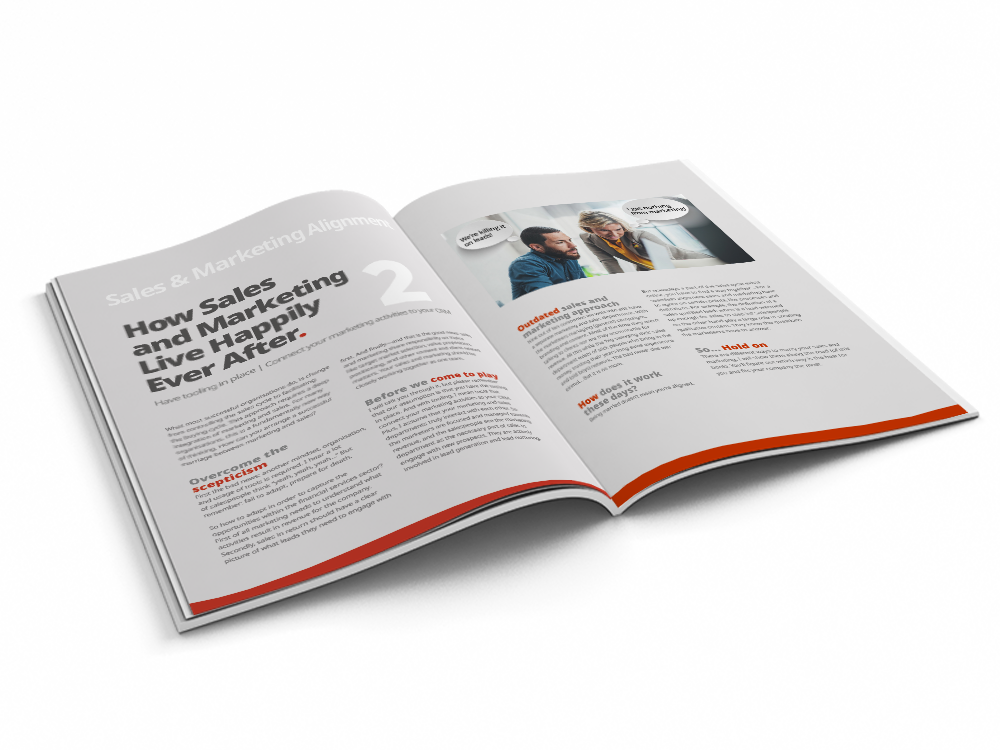
The 7 habits of highly effective fintechs
What are the 7 key habits that are continuously practised by successful fintechs? Follow the habits outlined in this e-book and you will be well on the way to growth.
